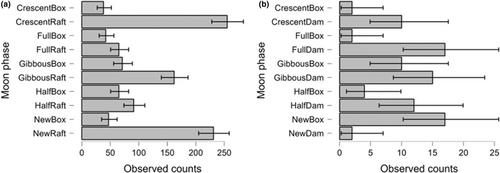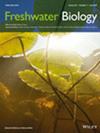多种方法采样提高了湿地生境中哺乳动物和鸟类时空相互作用的可探测性和评估能力
IF 2.8
2区 生物学
Q2 ECOLOGY
引用次数: 0
摘要
淡水栖息地支持高水平的生物多样性,并为依赖湿地的类群提供了重要的栖息地;然而,湿地丧失、溪流改变和光污染导致的水生连通性受损影响了物种的持久性和群落的恢复力。量化这些栖息地的占有率以评估哺乳动物和鸟类对其的利用情况是一项挑战,尤其是对隐蔽物种而言。本研究考察了加拿大阿尔伯塔省海狸山生物圈内哺乳动物和鸟类对湿地栖息地的利用情况及其时空关系。作为多方法检测方法的一部分,摄像箱、海狸坝上的摄像机和摄像筏可用于多变量分析,以确定栖息地使用和物种关联的时空模式,而野外取样和环境 DNA(eDNA)可提供半水生哺乳动物子集的地点占用数据。从约 50,000 张图像中,发现了超过 84 个物种,包括 52 种鸟类和 25 种哺乳动物。有几个物种在空间上有关联,虽然大多数哺乳动物物种在时间上有重叠,但也有明显的差异,特别是在海狸坝上,郊狼和白尾鹿等捕食者共享同一空间。从时间上看,鸟类最常在白天被发现,而哺乳动物则在夜间被发现。在新月期,海狸对海狸坝的使用大幅减少,而麝鼠对照相机木筏的使用则有所增加。通过冬季实地调查,可以大致了解湿地的占用情况和某些物种的数量,尤其是海狸和麝鼠,偶尔也会发现其他半水生哺乳动物的冬季活动。在对较为隐蔽的半水生哺乳动物物种检测有限的情况下,eDNA 分析比照相和野外方法更能成功地检测到美国水鼩、美国水貂、北美河獭和北部沼泽旅鼠。目前,淡水系统中受监测野生动物种群的相对丰度正在急剧下降,其中许多物种在传统调查中的代表性不足,因此采用多种方法监测湿地栖息地中的哺乳动物和鸟类至关重要。本文章由计算机程序翻译,如有差异,请以英文原文为准。

Multi-method sampling increases detectability and assessment of spatio-temporal interactions of mammals and birds in wetland habitats
求助全文
通过发布文献求助,成功后即可免费获取论文全文。
去求助
来源期刊

Freshwater Biology
生物-海洋与淡水生物学
CiteScore
5.90
自引率
3.70%
发文量
162
审稿时长
2 months
期刊介绍:
Freshwater Biology publishes papers on all aspects of the ecology of inland waters, including rivers and lakes, ground waters, flood plains and other freshwater wetlands. We include studies of micro-organisms, algae, macrophytes, invertebrates, fish and other vertebrates, as well as those concerning whole systems and related physical and chemical aspects of the environment, provided that they have clear biological relevance.
Studies may focus at any level in the ecological hierarchy from physiological ecology and animal behaviour, through population dynamics and evolutionary genetics, to community interactions, biogeography and ecosystem functioning. They may also be at any scale: from microhabitat to landscape, and continental to global. Preference is given to research, whether meta-analytical, experimental, theoretical or descriptive, highlighting causal (ecological) mechanisms from which clearly stated hypotheses are derived. Manuscripts with an experimental or conceptual flavour are particularly welcome, as are those or which integrate laboratory and field work, and studies from less well researched areas of the world. Priority is given to submissions that are likely to interest a wide range of readers.
We encourage submission of papers well grounded in ecological theory that deal with issues related to the conservation and management of inland waters. Papers interpreting fundamental research in a way that makes clear its applied, strategic or socio-economic relevance are also welcome.
Review articles (FRESHWATER BIOLOGY REVIEWS) and discussion papers (OPINION) are also invited: these enable authors to publish high-quality material outside the constraints of standard research papers.
 求助内容:
求助内容: 应助结果提醒方式:
应助结果提醒方式:


